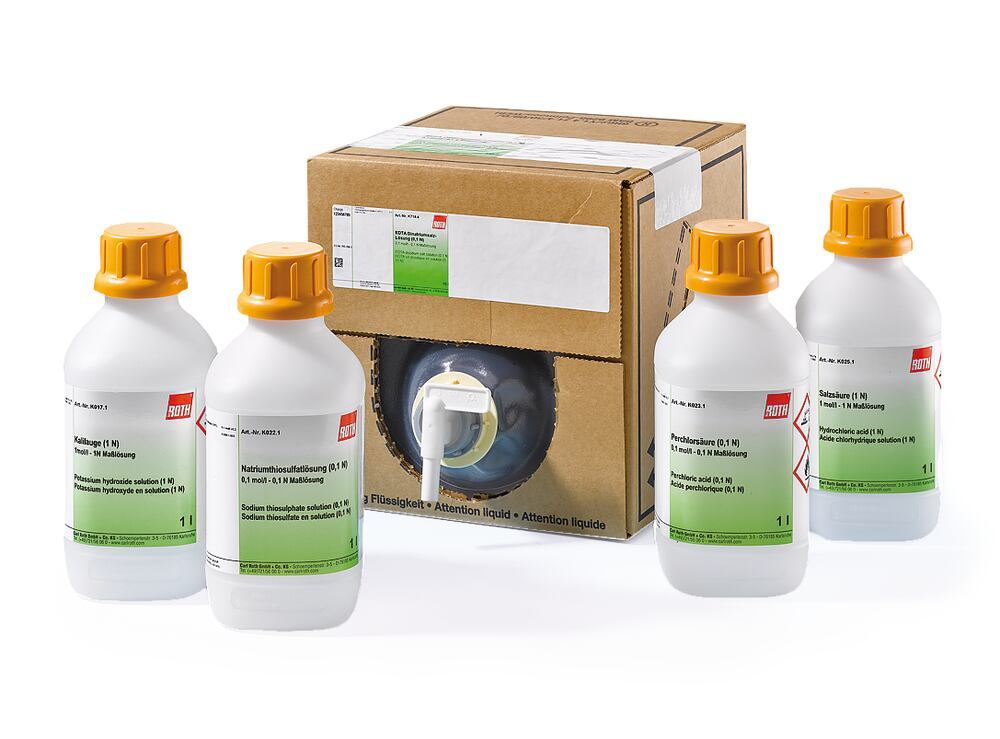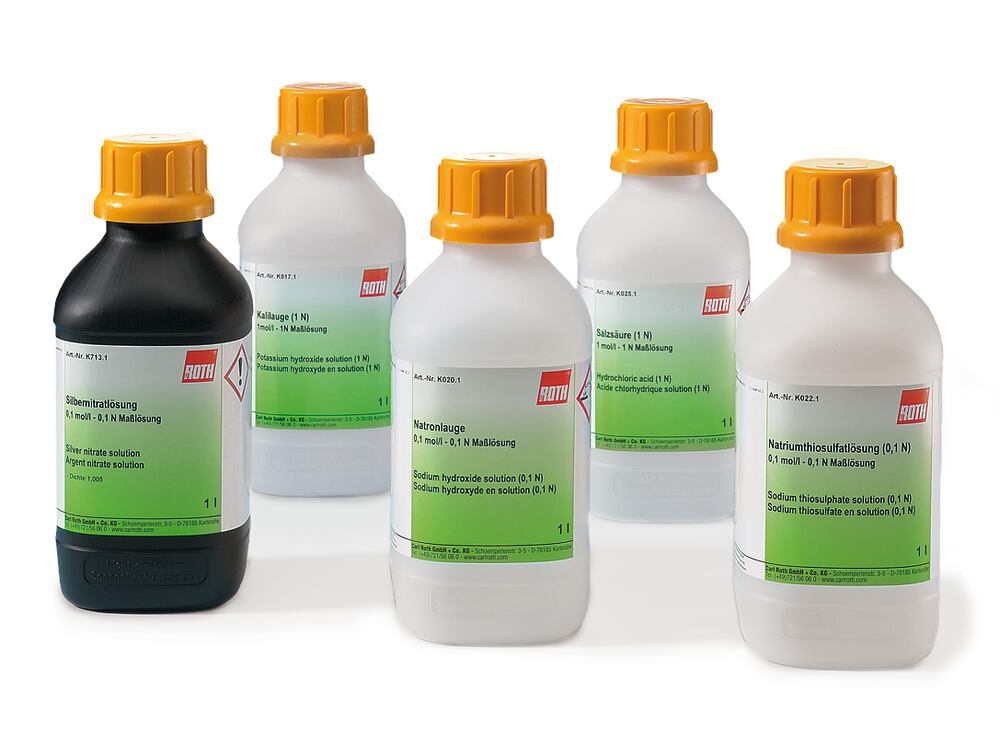product.details.print
Hydrochloric acid, 5 l, plastic
Molar mass (M) 36,46 g/mol
Density (D) 1 g/cm³
Boiling point (bp) 100 °C
ADR 8 III
WGK 1
CAS No. 7647-01-0
EG-Nr. 231-595-7
UN-Nr. 1789
79,45 €/VE
Excl. btw | 5 l Per VE
Bestelnr. K024.2
- Tussentotaal: 0.00
| Bestelnr. | VE | Verp. | Prijs | Hoeveelheid | |
|---|---|---|---|---|---|
| K024.1 | 1 l | plastic |
26,80 € |
|
|
| K024.2 | 5 l | plastic |
79,45 € |
|
|
| K024.3 | 5 l | ROTI®CUBE |
84,40 € |
|
|
| K024.4 | 10 l | ROTI®CUBE |
120,95 € |
|
|
| K024.5 | 500 ml | plastic |
21,00 € |
|
|
| K024.7 | 25 l | plastic |
217,70 € |
|
|
|
Op voorraad
Beschikbaar
In bestelling
Niet meer verkrijgbaar
Leveringsdatum onbekend
|
|||||
- Tussentotaal: 0.00
Downloads / MSDS
Algemene informatie
The most common technique for measuring the amount of nitrogen in organic matter is the Kjeldahl method, which is used in a wide range of sectors such as environmental analysis, food analysis, water analysis and agricultural analysis, as well as in the pharmaceutical and chemical industries. In this traditional method, a precisely weighed sample is broken down using concentrated sulphuric acid, a process which digests its organic contents and reacts nitrogen to form ammonium sulphate.(CHNO)(s) → CO2 (g) + SO2 (g) + H2O (g) + NH4SO4 (solv, H2SO4)A catalyst or catalyst mixture consisting of copper, selenium, mercury and/or titanium is added to speed up the reaction. Sodium or potassium sulphate is used to give the sulphuric acid a higher boiling point. If the nitrogen is contained in a nitro, nitroso or azo compound, however, the mixture must be reduced with zinc before digestion takes place.
The nitrogen is now present in the sulphuric acid as ammonium sulphate. Adding a strong base (such as NaOH) neutralises the sulphuric acid and liberates ammonia from the solution.NH4SO4 (solv) + 2 NaOH (aq) → Na2SO4 (aq) + 2 NH3 (g) + 2 H2O (l) The ammonia is led into an acid (such as boric acid) by means of steam distillation.B(OH)3 (aq) + 2 H2O (l) + NH3 (g) → B(OH)4- (aq) + NH4+ (aq) The resulting strong base (borate ion) is back-titrated with a strong acid (hydrochloric acid or sulphuric acid). The excess weak boric acid is not captured in the process. A Tashiro's indicator that changes colour in the acid is used for titration. The amount of acid that has been used up can then be converted into the amount of nitrogen in the sample. NH4+ (aq) + B(OH)4- (aq) + HCl (l) → NH4Cl (aq) + B(OH)3 (aq) + H2O (l)To calculate the protein content of the sample, the varying nitrogen content of the amino acids must be checked and the relevant conversion factors applied. The nitrogen contained in food derives mainly from proteins, but different samples may also contain other sources of nitrogen.
A volumetric standard solution is a solution containing a precisely known concentration of a substance. The concentration of a volumetric standard solution is determined using a primary standard, which is accurately weighed and dissolved to make a specific volume. Volumetric standard solutions are made using reagent-grade (p.a.) substances as source materials.
The advantages of this over making them yourself are:
- Manufactured and tested using modern manufacturing and analytical methods
- Ready-to-use solutions
- High accuracy for precise analyses
- Application of NIST-certified reference substances for checking
- Connection to standard titrators is possible
Determination of Water Hardness
Water contains a whole host of salts and other compounds in addition to the gases dissolved in it (oxygen, nitrogen, carbon dioxide). Its most important constituents are magnesium and calcium in the form of their chlorides, sulphates and bicarbonates. These dissolved salts are known as hardeners. The bicarbonates precipitate in the heat (during boiling) as carbonates and are known as carbonate hardness or temporary hardness. The sulphate and chloride compounds are known as permanent hardness or non-carbonate hardness. Total hardness describes the concentration of alkaline earth metal ions in water.
The unit of measurement for water hardness used to be 1 °dH (German degrees of hardness), which corresponds to 10,00 mg CaO or 7,19 mg MgO in one litre of water. Today we use millimoles per litre (mmol/l), whereby 1 °dH corresponds to 0,18 mmol/l of earth metal ions and 1 mmol/l corresponds to 5,6 °dH.
Analysecertificaten
Type analysis
| Amount-of-substance conc. (20 °C) | 0,1 mol/l ±0,2 % |
| Titer | 0,998-1,002 |



